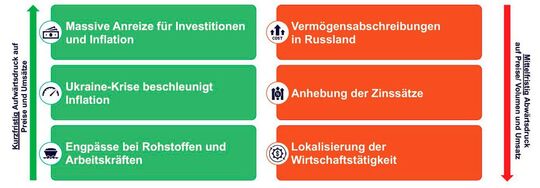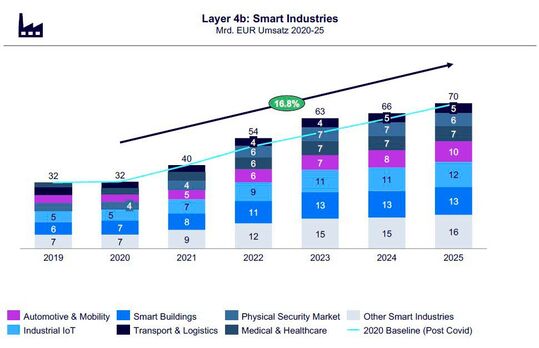Eco-forecast for the Internet economy
2022 to 2025: First hui, then ugh
Related providers
The Eco Association, together with the consulting and market research company Arthur D. Little, regularly conducts a study on the development of the Internet economy. The current version first predicts strong growth, then a slight contraction process.

Oliver Süme, Chairman of the Eco-Association, probably put the best news right at the beginning of the presentation of the current update of the industry monitor of the Internet economy: “The situation seems to be stable for 2022 to 2025.“ In view of the warlike upheavals in the East and numerous other uncertainties, perhaps an optimistic statement.
The last survey of the study, which has been carried out regularly since 2008, dates from 2020, i.e. from the beginning of the corona crisis. Compared to this period of stagnation, the circumstances have changed significantly.
Now the war in Ukraine is affecting business in several ways: through inflation and price increases, especially in energy, sanctions, liquidity and supply bottlenecks in intermediate products and raw materials, as well as an overall more difficult financing. In addition, there is the humanitarian and geopolitical crisis with escalation risks as an unsettling element.
Internet economy gets off to a good start due to Ukraine shock
But according to the forecast, the Internet economy is getting away with it somewhat unscathed. With the exception of voluntary restrictions on cooperation with Russian companies in the field of technology and media, it is not directly affected.
An exception are companies with a Russian origin – a prime example is the antivirus specialist Kaspersky – or Russian subsidiaries. But the latter is rather rare.
There is plenty of money in the market. After all, 1.7 trillion euros of stimulus is available in the wake of the Covid crisis to expand the TMT infrastructure (TMT = Technology, media and telecommunications).

(Photo by Eco/Arthur D. Little )
Rising costs would be passed on to customers, predicts Nejc Jakopin, principal at A. D. Little. Therefore, they would have to expect higher prices for the Intenet connections and services in the years 2022 and 2023.
Data Center operating costs rise
“The energy price peaks and supply bottlenecks are reflected, for example, in data center costs,” explains Jakopin. The entire industry is in a price-driving supply crisis. This also applies to the staff. “A lot of the local fiber-optic networks were laid by Ukrainian construction workers. But they are difficult to get at the moment.“
At the same time, demand is increasing – the volume of data transfer via the Internet has continued to grow steadily even during the Covid crisis. At the DE-CIX Internet hub, for example, it increased by 29 percent annually between 2018 and February 2022.
This results in a rocking movement for the industry as a whole in the years up to 2025: in the current phase, which according to Eco / A.D. Little will continue this year and could last until 2023, according to the study, prices and sales are rising more steeply than the long-term average.
Healthy shrinkage 2024/25?
Then the big end follows: due to a slump from 2024 to 2025, the market will return to the growth curve observed for many years. “There will be a cleanup here,” Jakopin predicts. “Providers should therefore now ensure sufficient reserves.“
The Eco study has always divided the Internet economy into four market segments: networks, infrastructures and their operation are fundamental (Layer 1). On top of this are services and applications (layer 2), an aggregation and transaction level (layer 3) and finally the digital business models of the individual providers (layer 4). Over the next three to four years, the segments and their sub-segments have a slightly different growth curve from the average, but also from each other.
Compared to the scenario that was developed during the Covid phase, the overall growth rates will be at least the same (layer 2) by 2025, but usually even slightly higher. There are different reasons for this on each shift.
Growth despite the crisis
The companies of the infrastructure layer are growing simply due to higher usage volumes, but also due to the passing on of cost increases in power production. Layer 2 is growing particularly strongly because cyber security, which is classified here, is becoming an urgent necessity and more and more users are using IaaS or SaaS.
At layer 3 (e-commerce, etc.), more e-commerce affinity of customers, scarcity, more expensive value creation and supply chains are reflected in growth-promoting ways. At level 4, it is especially more smart devices to reduce operating costs, but also more expensive content that increases growth.
Intelligent industries are growing strongly
The fourth layer (Digital Business Models) divides the study into two sub-areas, namely digital content (4a) and intelligent industries (4b).
Individual segments are in the intelligent industries automotive and mobility, industrial IoT, intelligent buildings, transport and logistics, physical security, medicine and healthcare and more. The study estimates the overall growth between 2020 and 2025 at 16.8 percent, which is particularly high.

(Photo by Eco/Arthur D. Little )
In detail, smart buildings are to grow from eight (2021) to 13 (2023-25) billion euros in sales, industrial IoT from 7 (2021) to 12 (2025) billion euros and automotive / mobility from five (2021) to ten billion euros in sales. The study identifies several reasons for this. These services are affected more than others by inflation and macroeconomic influences.
The rise in utility prices is encouraging the fastest possible switch to smart devices. Industrial and administrative customers would therefore also modernize their networks as quickly as possible.
Smart buildings one of the leaders
If we look at when and how much the growth of individual segments of the fourth layer deviates from the long-term average, it turns out that the biggest upward divergences in 2022/23 can be expected in the smart buildings industry. During this time, it is increasing by up to 20 percent more than can be expected for many years.
But the mountain of growth passes the automotive industry without a trace. It is underperforming in 2022 and 2023 and will not gain anything until 2024, when most other segments of the Internet economy are currently consolidating.
Mobile access overtakes fixed Internet access
The predicted developments for Layer 1 (infrastructure) are also interesting: a stronger increase in this area is expected in 2022 and 2023, especially in the access network for the mobile Internet. This is probably due to the further expansion of 5G infrastructures and applications. In 2025, this segment is expected to generate sales of 18 billion euros, in 2021 it was still 15 billion euros.
Another interesting development is that co-location and housing should grow significantly. According to the forecasts, they will implement 13 billion euros in 2025, for 2021 the study calls 11 billion euros.
For this, the market segment “hardwired Internet access networks” could shrink by one billion euros in 2025 compared to the previous year. It should then generate the same revenue as in 2021, namely 11 billion euros. This puts it in third place, no longer in second place of the market segments in the infrastructure layer as before.
(ID:48395374)

